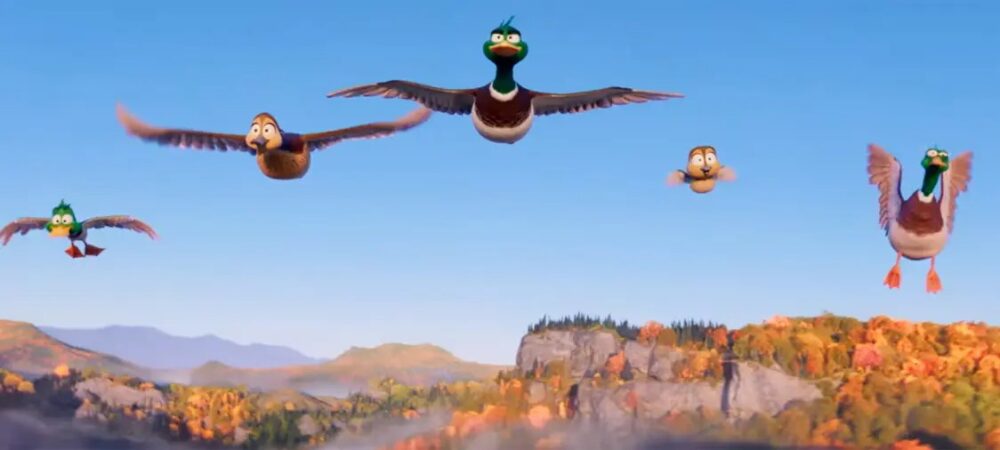|
Getting your Trinity Audio player ready...
|
Forget The Bachelor ─ the actual perfect marriage of 2023 has been that between stirring, moving music and groundbreaking visual imagery in this year’s animated features. Many of these noteworthy (and potentially Oscar-worthy) musical scores reveal as much breadth and scope as the films themselves.
Daniel Pemberton’s score for Sony/Marvel Entertainment’s Spider-Man: Across the Spider-Verse alone runs the gamut of musical styles, instrumentation and sounds, including a few that were created on the spot. Pemberton, who also scored 2018’s Oscar-winning Spider-Man: Into the Spider-Verse, says the challenge this time was the film’s sheer scope. “In the first film you were dealing with Miles’ world, but in Across you’ve got five or six very different universes,” he says. “I had to create different sonic identities for each universe in the same way the artists were creating very distinctive looks for every world.”

Synth Sounds and Scratching
Working closely with hip-hop record producer Metro Boomin, Pemberton relied heavily on electronic music and synthesizers, creating a “dreamlike, washy synth sound” to blend with a ’90s grunge aesthetic for Gwen Stacy’s Earth-65 world, while the universe of 2099 featured a more technologically edgy and aggressive sound. Protagonist Miles Morales’ world, meanwhile, was characterized by hip-hop culture and aural record-scratching.
‘I think this is the first Hollywood film to feature a record-scratched goose honk because there was a kind of boundary-pushing creative freedom that was encouraged.’
— Spider-Man: Across the Spider-Verse composer Daniel Pemberton
“A lot of the things you’re seeing on screen have sound effects that are being scratched in,” Pemberton says. “We’ve got a car-crash sound, some punch sounds, Miles’ drawing with felt tips that are all scratched, and when they fight with this goose that has flown into their vortex, I said, ‘Why are we not scratching the goose?’ So, I think this is the first Hollywood film to feature a record-scratched goose honk, and it actually sums up this film, because there was a kind of boundary-pushing creative freedom that was encouraged.”
While Pemberton calls his work on Across the Spider-Verse “probably the most complicated film score I’ve ever done,” the hallmark for Joe Hisaishi’s score for the legendary Hayao Miyazaki’s The Boy and the Heron, produced by Studio Ghibli and released in the U.S. by GKIDS, was finding emotion through simplicity.

“When I first saw this movie, I noticed how unlike [Miyazaki’s] other movies it was,” says the composer, who has collaborated extensively with the director over the decades. “It has a dark setting and was emotionally tearing. He really put a lot of himself into this movie. Before, I used melody to represent more emotional elements, but I tried to steer away from that this time and match his world with a minimalist part of my music.”
A good portion of the score is built upon a pensive piano solo (which was played by Hisaishi, who is a noted concert pianist), though his adherence to simplicity became more of a challenge with the key character of the Grey Heron. “When he first appears it’s one piano sound,” Hisaishi says. “The next time he appears, it’s two piano sounds. I really had to talk it through with Mr. Miyazaki to make it more simplified but impactful.”
‘Before, I used melody to represent more emotional elements, but I tried to steer away from that this time and match his world with a minimalist part of my music.’
— The Boy and the Heron composer Joe Hisaishi
Unlike their earlier collaborations, Hisaishi says that he was kept in the dark, so to speak, until the film was largely completed. “Before, he would show me storyboards or animation reels that were half done, so I could start composing,” he says. “This time there was no access until almost the end. He didn’t give me any [advance] input on what he wanted. He just said, ‘I’m going to leave it all to you.’”
If a scratched goose and a heron weren’t enough, the focus on waterfowl in 2023 reached a zenith through Universal/Illumination’s Migration. To create the film’s lush underscore, composer John Powell used an orchestra with more than 100 players, a chorus of about a dozen singers — and yes, a duck. “It’s heard just before the end titles,” he notes. For another cue, the choir was asked to sing like ducks. “I wasn’t convinced it would work,” Powell admits. “But our director [Benjamin Renner] found it extremely funny.”

Melodies Take Flight
Nearly all of the film’s characters are avian, and Powell created the music not so much to evoke birds, but to support their all-too-human personalities. For star Mack Mallard, who is first seen extolling the small pond that his family calls home and warning against ever leaving it, Powell crafted a musical theme that sounded, in his words, stuck.

“I wanted a tune that didn’t seem to go anywhere,” he says, “but later becomes grand, joyful and heroic as Mack conquered his fears.” To capture the pugnaciously crazy nature of Chump, the pugnacious, streetwise leader of a gang of inner-city pigeons, Powell experimented with an African harp called a kora. “Normally, it’s used with guitars in blues,” he says. “But playing it with a bottleneck and sliding around on it seemed to capture Chump’s dangerous but wonky character.”
To underscore New York City itself, the composer eschewed the musical riffs that have defined the metropolis on screen for decades. “To this family of ducks, New York isn’t the cultural icon that humans know; it’s an extraordinary and alien world,” he says. “I did my best to forget everything I know about the music we associate with New York and simply scored the emotional reveal of such a crazy new world.”
Vocal augmentations appear in the scores for several of this year’s films, including The Boy and the Heron. But in the case of Disney/Pixar’s Elemental, lyrics were absent.

“In terms of the dreamier vocals, they were vowels that could turn,” says composer Thomas Newman (who with his cousin Randy have between them scored about half of all Pixar features). “The notion of words would have been tough anyway, but there were a couple of sequences in Element City where the syllables were derived from the language that [director] Pete Sohn had created for fire.” Working with woodwind player Steve Tavaglione, who has mastered an EWI (electronic wind instrument), Newman achieved specific sounds and sonic colors that were the basis for the vocalization.
Having humanoid, but not human characters, in a completely fabricated world made it a challenge, Newman says. “I know music that sounds like fire, music that sounds like water, music that has misty qualities to sound like vapor or clouds, but I had to reject that for the most part because I knew it would be redundant to what was going to be obvious use of sound design. But pulling from all kinds of instruments in different ways gave me license to say, ‘Hey, this works.’”
‘I know music that sounds like fire, music that sounds like water, music that has misty qualities to sound like vapor or clouds, but I had to reject that for the most part because I knew it would be redundant.’
— Elemental composer Thomas Newman
Like most live-action features, Newman’s work on Elemental began after the editing had been finalized. “They had to commit to an edited movie pretty early on because they were so obligated to the special effects: the movement of water, fire, refracting light, that stuff. But one of the values of a composer coming in [late] is you bring a fresh set of eyes and ears and a fresh take on everything.”

Polish Pipes
Targeting a completely different audience than its family-friendly counterparts is Breakthru Films’ The Peasants, DK Welchman and Hugh Welchman’s follow-up to 2017’s Loving Vincent. Like its predecessor, it was filmed in live-action and then painted over, frame by frame, in oils, and it tells the forceful and sometimes brutal story of a young woman in a small Polish village in the early 20th century. Fulfilling a long-held dream to write film music, conceptual musician and rapper Lukasz “L.U.C” Rostkowski strove to match the sound of the music with the intensity of picture. “I didn’t think it was going to be suitable to use a huge, symphonic orchestra for this intimate film set in a small, poor village in very hard times,” he says. “I wanted to stick to the original, historical instruments.” These included a Slavic accordion, Polish bagpipe, clarinet and a stringed suka.

The score was performed by the Rebel Babel Film Orchestra, which is as peripatetic as it is proficient. “We travel around the world and always involve local musicians,” L.U.C. says. For The Peasants, local vocalists were employed as well. One group of singers provided a level of poignancy that was unexpected. “We had this amazing amateur Ukrainian choir — war refugees who came to Poland. They told me that when they sing, it is the only time they are not thinking about their husbands fighting on the front line.”
For the film’s boisterous dance sequences, L.U.C. used an almost traditional band, with an anachronistic trumpet. “I found [these] amazing band[s] Tęgie Chłopy and Laboratorium Pieśni, which wasn’t a typical Polish folk band, because a typical Polish folk band was accordion, fiddles, some drum and sometimes clarinet.” His most challenging work, though, was scoring the gut-wrenching scene in which the film’s heroine Jagna is raped. “I made 26 approaches to this scene,” he says. “This loss of hope, this moment where she’s changing into a kind of ice girl, when she’s losing the last elements of her sensitivity … it was hard to find the right tone.”
As animation continues to find new and different ways to amaze us visually, its aural partnership with many of today’s top composers remains just as vital. If you don’t believe that, just go listen to a movie sometime.
Michael Mallory is an award-winning author and journalist whose many books include Universal Studios Monsters: A Legacy of Horror, Marvel: The Characters and Their Universe and Hanna-Barbera Cartoons.












 Win 'The Art of DreamWorks Dog Man'!
Win 'The Art of DreamWorks Dog Man'! 

